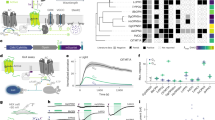Abstract
CALCIUM release from intracellular stores is a point of convergence for a variety of receptors involved in cell signalling1. Consequently, the mechanism(s) by which cells differentiate between individual receptor signals is central to transmembrane communication2–5. There are significant differences in timing and magnitude of Ca2+ release stimulated by the m2 and m3 muscarinic acetyl-choline receptors6–11. The m2 receptors couple to a pertussis toxin-sensitive G protein to activate phosphatidyl inositol hydrolysis weakly and to stimulate small, delayed and oscillatory chloride currents. In contrast, m3 receptors potently activate phosphatidyl inositol hydrolysis and stimulate large, rapid and transient chloride currents by a pertussis toxin-insensitive G protein pathway. Using confocal microscopy, we now show that the m2- and m3-coupled Ca2+ release pathways can also be spatially distinguished. At submaximal acetylcholine concentrations, both receptors stimulated pulses of Ca2+ release from discrete foci in random, periodic and frequently bursting patterns of activity. But maximal stimulation of m2 receptors increased the number of focal release sites, whereas m3 receptors invariably evoked a Ca2+ wave propagating rapidly just beneath the plasma membrane surface. Analysis of pertussis toxin sensitivity and hybrid m2–m3 muscarinic acetyl-choline receptors confirmed that these Ca2+ release patterns represent distinct cell signalling pathways.
This is a preview of subscription content, access via your institution
Access options
Subscribe to this journal
Receive 51 print issues and online access
$199.00 per year
only $3.90 per issue
Buy this article
- Purchase on Springer Link
- Instant access to full article PDF
Prices may be subject to local taxes which are calculated during checkout
Similar content being viewed by others
References
Berridge, M. J. & Irvine, R. F. Nature 341, 197–205 (1989).
Berridge, M. J., Cobbold, P. H. & Cuthbertson, K. S. R. Phil. Trans. R. Soc. B 320, 325–343 (1988).
Brooker, G., Seki, T., Croll, D. & Wahlestedt, D. Proc. natn. Acad. Sci. U.S.A. 87, 2813–2817 (1990).
Rooney, T. A., Sass, E. J. & Thomas, A. P. J. biol. Chem. 265, 10792–10796 (1990).
Berridge, M. J. J. biol. Chem. 265, 9583–9586 (1990).
Lechleiter, J. et al. EMBO J. 9, 4381–4390 (1990).
Fukuda, K. et al. Nature 327, 623–625 (1987).
Fukuda, K. et al. Nature 335, 355–358 (1988).
Peralta, E. G. et al. Nature 334, 434–437 (1988).
Ashkenazi, A. et al. Cell 56, 487–493 (1989).
Lechleiter, J. Peralta, E. G. & Clapham, D. Trends pharmacol. Sci. (Suppl.) 34–38 (1989).
Parker, I. & Ivorra, I. Proc. natn. Acad. Sci. U.S.A. 87, 260–264 (1990).
Majerus, P. W. et al. Cell 63, 459–465 (1990).
Hernandez-Cruz, A., Sala, F. & Adams, P. R. Science 247, 858–862.
Fabiato, A. & Fabiato, F. J. J. Physiol. Paris 75, 463–505 (1979).
Author information
Authors and Affiliations
Rights and permissions
About this article
Cite this article
Lechleiter, J., Girard, S., Clapham, D. et al. Subcellular patterns of calcium release determined by G protein-specific residues of muscarinic receptors. Nature 350, 505–508 (1991). https://doi.org/10.1038/350505a0
Received:
Accepted:
Issue Date:
DOI: https://doi.org/10.1038/350505a0
This article is cited by
-
A novel mechanism of hippocampal LTD involving muscarinic receptor-triggered interactions between AMPARs, GRIP and liprin-α
Molecular Brain (2009)
-
Ca2+ spiral waves in a spatially discrete and random medium
European Biophysics Journal (2009)
-
Xenopus tropicalis oocytes as an advantageous model system for the study of intracellular Ca2+ signalling
British Journal of Pharmacology (2001)
-
Localized measurement of kinase activation in oocytes of Xenopus laevis
Nature Biotechnology (1999)
-
Inositol 1,4,5-trisphosphate formation and ryanodine-sensitive oscillations of cytosolic free Ca2+ concentrations in neuroblastoma�fibroblast hybrid NL308 cells expressing m2 and m4 muscarinic acetylcholine receptor subtypes
Pfl�gers Archiv European Journal of Physiology (1995)
Comments
By submitting a comment you agree to abide by our Terms and Community Guidelines. If you find something abusive or that does not comply with our terms or guidelines please flag it as inappropriate.



